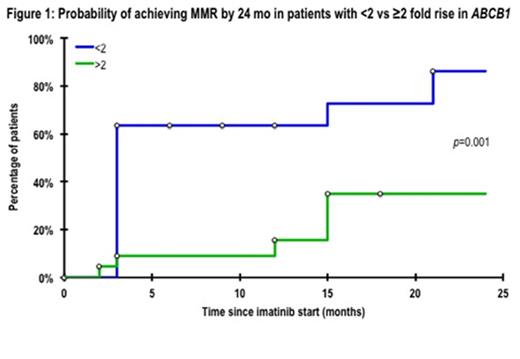Abstract

Recent data from the TIDEL II trial indicate first-line imatinib (IM) treatment, with selective switching to nilotinib (NIL) for failure to meet specific molecular targets or for intolerance, results in excellent molecular response and overall survival in chronic phase Chronic Myeloid Leukaemia (CP-CML) patients. Drug transporters, particularly OCT-1 and ABCB1, have previously been demonstrated to impact IM response. Furthermore, ABCB1 overexpression has been implicated in IM and NIL resistance in vitro. In this TIDEL II sub-study the level of ABCB1 mRNA expression was retrospectively assessed by PCR at day 0 and day 22 post the start of IM therapy and where relevant, at cessation. A change in the level of expression of ABCB1 compared with baseline after 22 days exposure to IM was observed in all patients (Range: 0.6-12.3 fold; median: 2 fold), suggesting IM exposure resulted in altered ABCB1 expression that was variable between patients; this change was not related to the level of BCR-ABL1 expression (p=0.29 at day 0 and p=0.84 at 1 mo). Assessing the impact of >2 fold rise in ABCB1 expression after 22 days IM exposure on subsequent molecular response, and comparing this with patients where a <2 fold rise was observed revealed significant differences in outcome between the 2 groups (Table 1).
| . | % of patients achieving: . | |||
|---|---|---|---|---|
| Over the first 22 days of treatment . | Early Molecular Response . | MMR by 12 mo . | Event Free Survival . | MR4.5 . |
| <2 fold rise in ABCB1 (n=22) | 86% | 64% | 77% | 64% |
| >2 fold rise in ABCB1 (n=22) | 60% | 14% | 37% | 5% |
| p -value | 0.006 | 0.001 | 0.018 | <0.001 |
| . | % of patients achieving: . | |||
|---|---|---|---|---|
| Over the first 22 days of treatment . | Early Molecular Response . | MMR by 12 mo . | Event Free Survival . | MR4.5 . |
| <2 fold rise in ABCB1 (n=22) | 86% | 64% | 77% | 64% |
| >2 fold rise in ABCB1 (n=22) | 60% | 14% | 37% | 5% |
| p -value | 0.006 | 0.001 | 0.018 | <0.001 |
Importantly, change in ABCB1 mRNA over the first 22 days of treatment was predictive of MMR by 24 mo (Figure 1).
These data support previous in vitro findings of ABCB1-mediated IM export and provide the first in vivo evidence for up regulation of ABCB1 in response to IM therapy. Because ABCB1-mediated export of NIL has also been demonstrated, we assessed the correlation between response to NIL therapy and changes in ABCB1 expression following 22 days IM exposure. Of the patients who demonstrated a >2 fold rise in ABCB1 compared with baseline, 16 of the remaining 20 patients (2/22 died at 3.2 mo (Cardiac event) and 3.7 mo (Blast Crisis)) switched to sequential NIL therapy because of sub-optimal response to IM (no prior MMR). Importantly, 0/16 patients receiving NIL subsequently achieved confirmed MMR, suggesting that NIL may provide a poor therapeutic option for patients with up-regulation of ABCB1. These data highlight the potential importance for monitoring increases in ABCB1 expression early in therapy in order to predict those patients likely to achieve poor molecular responses. We next determined the impact of ABCB1 expression on Event Free Survival (EFS) and demonstrated that the fold change in ABCB1 levels at day 22 was predictive for achieving EFS: 77% of patients with <2 rise in ABCB1 vs 37% of patients with >2 rise in ABCB1; p =0.018. Furthermore a sustained >2 fold rise in ABCB1 mRNA compared with levels at diagnosis was observed in 3/3 patients prior to progression to blast crisis and ABCB1 mRNA increased by >2 fold post therapy in 9/12 patients prior to development of KD mutations.
Previous studies investigating the correlation between ABCB1 expression and response to therapy have focussed on absolute levels of ABCB1, usually at 12 mo post-therapy initiation when leukaemic cell burden would be low, and have observed no significant difference in ABCB1 expression in optimal vs sub-optimal responders. Conversely, our rapid PCR based assay performed pre and 22 days post the start of IM therapy in CP-CML patients provides a potent early predictor of subsequent IM response. The findings detailed here also suggest that NIL is likely a poor subsequent therapeutic option for patients with up-regulated ABCB1 expression in response to IM. Importantly, these data highlight the fact that better understanding of the effects of TKIs on factors with the potential to influence treatment outcome (such as drug transporter expression) can be used to personalise therapy. Overarchingly, these data exemplify the importance of drug transporters in the setting of TKI therapy and patient response, and, following validation in further studies, provide a new, effective and easily translatable prognostic biomarker based on ABCB1.
Hughes:Bristol-Myers Squibb: Honoraria, Research Funding; ARIAD: Honoraria, Research Funding; Novartis: Honoraria, Research Funding. White:Novartis: Honoraria, Research Funding; BMS: Honoraria, Research Funding.
Author notes
Asterisk with author names denotes non-ASH members.

This icon denotes a clinically relevant abstract


